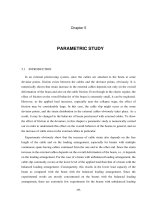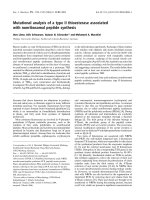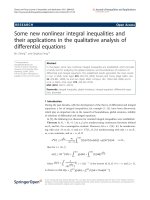NUMERICAL ANALYSIS PROBLEM DIFERENTIAL EQUATIONS II
Bạn đang xem bản rút gọn của tài liệu. Xem và tải ngay bản đầy đủ của tài liệu tại đây (154.83 KB, 14 trang )
WEBSITE :
NUMERICAL ANALYSIS PROBLEM DIFFERENTIAL EQUATION II
6200
1.
Answer :
From the figure above, we have :
T T T T
T
T
T
min
T
min min
T
h
T
1 1
c s (c s) cot cot ,c h , : the radius of the inscribed
circle
2 2 2 2
Let the three int erior angles of T be a b c
h
1 1
cot cot
2 2 2 2
We have :
by a cons tant for all h
h
T then for som
α β
= + − = ρ + ρ = ρ
θ = α ≤ β ≤ γ ⇒ ≤ ≤
α β
⇒ = +
ρ
θ ≤ θ
⇔ θ ≤ α ≤ β ≤ γ θ
∀ ∈ Τ ≤ σ
ρ
T
T
min
T
T
min min
e
h
1 1
We have : cot cot
2 2 2 2
Because and cot is a decrea sing function so
h
1 1
cot cot
2 2 2 2
cot cot where cot
2 2 2
σ
α β
= +
ρ
θ ≤ α ≤ β
α α
≤ +
ρ
α θ θ
≤ ≤ σ =
2.
Answer :
a) Difference between regular and uniform grid
T
T T h
T
T
T
h
Regular : , such that h h h,where h maxh ,T
h
Uniform grid : , h max h , K 0
K
The regular grid is stronger than the uniform grid
b)The mesh in the figure includes both uniform and regular grid
≤ σ ∃α α ≤ ≤ = ∈ Τ
ρ
≤ σ = >
3.
Answer :
j
j j
1
j
1
j
1 1
j z
j
1
z z
j
h
a)Show that tan
x 2
h
tan
x 2
h h
tan dx tan .x
2 2
We know that :
1
h h
tan .x 1 x tan
2 2
h
This is true when we have known that z tan , 0
2
−
−
− −
−
∂
φ = θ
∂
∂
φ = θ
∂
⇒ φ = θ = θ
φ =
⇔ θ = ⇒ = θ
= θ
∫
( )
2
2
j
I
b)Consider the function u(x,y) y .
Its linear int erpo tant vanishes at z and equals
h / 4 at the two other vertices
Show that
h
u u
x 2tan
=
∂
− =
∂ θ
( )
( )
j
j
j
j j
I
2
2
z
I z
2
z
2
z z
j
Answer :
h
u u
x 2tan
h
With u(x,y) y (u)
4
h h
u u dx .x
2tan 2tan
We know that :
h
(u)
4
h h h
.x x tan
2tan 4 2
h
This is true when we have known that z tan , 0
2
From the parts above, we can see that
Genera
∂
− =
∂ θ
= ⇒ φ =
⇒ − = =
θ θ
φ =
⇔ = ⇒ = θ
θ
= θ
∫
lly, then the are of traingle T,which have creat
ed
by (0,h / 2);(0, h / 2) and (h / 2tan ,0) is− θ
j
j
2
z
2
0
z
1 h h 1 h h h
(u) . . tan . . tan tan
2 2 2 2 2 2 4
h
Hence, if (u) then tan 1 45
4
But, we have the shape regularity condition :
φ = θ + θ = θ
φ = θ = ⇒ θ =
T min
T
min
h
cot cot
2 2
1
tan
2
θ
θ
= ≤
ρ
≤
θ
min T
T
0
min
min
tan tan
2 h 2
45
tan 1
Thus,the tan may be cause large error
θ ρ
θ
⇔ ≤ =
θ ≤ θ =
θ ≤
θ
4.
"
Consider the BVP problem : find a periodic funct
ion u such that
u (x) f(x) on ( 1,1 )− = Ω = −
a) State the weak formulation a(u,v) (v)
=
Answer :
First. We multiply the equation by test function v(x)
[ ]
" 1
1 1
"
1 1
'
" '
1 1
" ' ' '
1 1
1
' ' ' '
1
u v fv on ( 1,1 ), v H ( 1,1 )
We compute the weak form by int egrating over 1,1
u v dx fv dx
Set p v dp v dx
dq u dx q u
1
So : u v dx u .v u v dx
1
u (1).v(1) u ( 1).v( 1) u v dx
Where we have used t
− −
− −
−
− = Ω = − ∈ −
−
− =
=
⇒
=
=
⇒
=
− = − + =
−
= − + − − +
∫ ∫
∫ ∫
∫
' '
1 1
' '
1 1
1
2
1
hat u( 1) u(1) 0 u ( 1) u (1) 0
Hence, a(u,v) u v dx , (v) fv dx
u( 1) u(1) 0 f L and f dx 0
so u c is a solution
− −
−
− = =
⇒
− = =
= =
− = = ∈ =
+
∫ ∫
∫
b) Use the Lax-Milgram theorem to prove the existence and stability of the solution
Recall
: The Lax–Milgram theorem
This is a formulation of the
Lax–Milgram theorem
which relies on properties of the
symmetric part of the bilinear form. It is not the most general form.
Let
V
be a Hilbert space and a bilinear form on
V
, which is
1. bounded: and
2. coercive:
there is a unique solution to the equation
a
(
u
,
v
) =
l
(
v
)
Answer :
+ We will prove the property 1 : bounded:
We have
( )
1 1
' ' 1
1 1
a(u,v) u v dx , (v) fv dx ,H H
− −
= = = Ω
∫ ∫
1 1
' ' ' '
1 1
1/2 1/2
1 1
2 2
' '
1 1
H H
a(u,v) u v dx u v dx
u dx v dx (applying to Cauchy Schazt inequality)
C. u . v ,C 1
− −
− −
= ≤
≤ −
≤ =
∫ ∫
∫ ∫
1/2 1/2
1 1 1
2 2
1 1 1
(u) fv dx f dx v dx
− − −
= ≤
∫ ∫ ∫
2 2
L . H L .
H
f v ,C f
C. v
≤ =
≤
+ We continue to prove the property 2 : coercive:
( ) ( )
( )
( )
( )
( )
( )
(
)
( )
2 2
2
2
1
L L
2
x x
2
2 ' 2 '
1 1
2
2 2
2
2
2 '
L
L
We will prove the Poincare inequality :
u C. u , u H
We see that
u (x) u( 1) u (t)dt 2 u ( 1) u (t) dt
for 1 x 1
( We have used Cauchy 's inequality : a b 2 a b )
We have : u 2. u ( 1) u
For
Ω Ω
− −
Ω
Ω
≤ ∇ ∀ ∈ Ω
= − + ≤ − +
− < <
+ ≤ +
≤ − +
∫ ∫
( )
( )
( )
( )
( )
( )
( )
( ) ( ) ( )
(
)
( )
( )
( )
( ) ( )
2
2
2
1
2
2 2 2 2
L
L L L L
2
L
1
1
L
2
2
'
L
L
2 2 2 2
2 2
' ' ' '
H
2
' ' '
2
H
1 1
u H with u( 1) u(1) 0 u 0 , is boundary
u 2 u
Poincare inequality means :
u u u u 2 u 3 u 3a u,u
Where a(u,u) uu dx u
1
Thus, a u,u u
3
! u H such that a u,u (u), v H
Ω
Ω Ω Ω Ω
Ω
Γ
Ω
Ω
Ω
Ω
Ω
∈ Ω − = =
⇒
= Γ
⇒
≤
≤ + ≤ + = =
= =
≥
⇒
∃ ∈ Ω = ∀ ∈
∫
( )
Ω
c)
0o 1 2 n
n h
n n n n n
ij ji j i i j
n n
h i i i i n n i i
i 1 i 1
i n
n
n 1 n i i
i 1
i n
h 1 n 2
Partition as 1 x x x . . . x 1
u H H
a(u ,v ) (v ) , v H
The stiffness matrix is symmetric
if A A a( , ) a( , )
We have u u u u u
u ( ) u
So H span , , .
= ≠
≠
≠
≠
Ω − = < < < < =
∈ ⊂
= ∀ ∈
= ⇔ φ φ = φ φ
= ϕ = ϕ + ϕ + ϕ
= ϕ + ϕ + ϕ
= ϕ + ϕ ϕ
∑ ∑
∑
{ }
n 1
. . ,
−
ϕ
ij ij ij
i 1,j ij i 1,j i,j 1 ij i,j 1
u u f
u 4u u u 4u u
6 6
+ + − +
+ =
+ + + +
⇔ +
Thus,
2
ij
1 4 1
h
A 4 16 4
36
1 4 1
=
. This stiffness matrix is symmetric
d)
Set up a set equations based on finite differenc
es
1
0 1
1 2 3 4
j j
i i
ij
From the figure above ,we have the equations :
(1 y)(1 x) ; x(1 y) ; xy ; (1 x)y
Using the Intergrating to compute
K h ( )dx dy ; [0,h] [0,h]
x x y y
ϕ = − − ϕ = − ϕ = ϕ = −
∂ϕ ∂ϕ
∂ϕ ∂ϕ
= + ×
∂ ∂ ∂ ∂
∫
1
0 1
1 1 1 1
11
3 3
1 1
2 2
0 0
K ( )dxdy ; [0,1] [0,1]
x x y y
1 1
(1 y) (1 x) 2
h (1 y) (1 x) dxdy h h
3 0 3 0 3
∂ϕ ∂ϕ ∂ϕ ∂ϕ
= + = ×
∂ ∂ ∂ ∂
− −
= − + − = + =
∫
∫ ∫
1
0 1
2 2 2 2
22
3 3
1 1
2 2
0 0
K h ( )dxdy
x x y y
1 1
(1 y) x 2
h (1 y) x dxdy h h
3 0 3 0 3
∂ϕ ∂ϕ ∂ϕ ∂ϕ
= +
∂ ∂ ∂ ∂
−
= − + = + + =
∫
∫ ∫
1
0 1
3 3 3 3
33
3 3
1 1
2 2
0 0
K h ( )dxdy
x x y y
1 1
(1 y) x 2
h (1 y) x dx dy h h
3 0 3 0 3
∧ ∧
∂ϕ ∂ϕ ∂ϕ ∂ϕ
= +
∂ ∂ ∂ ∂
−
= − + = + + =
∫
∫ ∫
1
0 1
1 2 1 2
12 21
3 2 3
1 1
2
0 0
K K ( )dxdy ; [0,1] [0,1]
x x y y
1 1
(1 y) x x 1
h (1 y) (1 x)x dxdy h h
3 0 2 3 0 2
∂ϕ ∂ϕ ∂ϕ ∂ϕ
= = + = ×
∂ ∂ ∂ ∂
−
= − − + − = − + − =
∫
∫ ∫
[ ]
1
0 1
3 3
1 1
13 31
2 3 2 3
1 1
0 0
K K h ( )dxdy
x x y y
1 1 1 1
y y x x 1
h (1 y)y (1 x)x dx dy h h
2 0 3 0 2 0 3 0 3
∂ϕ ∂ϕ
∂ϕ ∂ϕ
= = +
∂ ∂ ∂ ∂
= − − − − = − + − + = −
∫
∫ ∫
1
0 1
3 3
2 2
23 32
2 3 3
1 1
2
0 0
K K h ( )dxdy
x x y y
1 1
y y x 1
h (1 y)y x dxdy h h
2 3 0 3 0 2
∂ϕ ∂ϕ
∂ϕ ∂ϕ
= = +
∂ ∂ ∂ ∂
= − − = − + + =
∫
∫ ∫
The element stiffness matrix
2 1 1
3 2 3
1 2 1
K h
2 3 2
1 1 2
3 2 3
−
⇒ =
−
We have the matrix four the aparts so :
(
)
( )
( ) ( )
( ) ( )
ij i j
1 1
1 2 1 1 2 3
1 3 3 1
A a ,
2 8
a , 4
3 3
1
a , . d x d y 2 1 a ,
2
1
a , a ,
3
1 3 1
1
A 3 8 3
3
1 3 1
= ϕ ϕ
⇒ ϕ ϕ = × =
⇒ ϕ ϕ = ∇ ϕ ∇ ϕ = × = = ϕ ϕ
ϕ ϕ = ϕ ϕ = −
− −
⇒ =
− −
∫
e)
We have
1
' '
1
1
1
a(u,v) u (x)v (x)dx
(v) f(x)v(x)dx
a(.,.) is binear form
−
−
=
=
∫
∫
0 1 n 1 n
1 x x . . . x x 1
−
− = < < < < <
{ }
h
h
h
n n
h j j 0 0 n n j j
j 0 j 0
n 1 2 n 1 0 n
V is the space of all continuous functions and be subspace of V
V have the value 0 at the endpoint s of [ 1,1] and ha
ve n 1 dimensions
Let u is solution of the subspace
u
Basic f , , . . . , ,
We h
= ≠
−
− −
= α ϕ = α ϕ + α ϕ + α ϕ
= ϕ ϕ ϕ ϕ + ϕ
∑ ∑
2
h h
h
'
h h
h h
' ' "
L ( 1,1)
ave a(u ,v) (v) , v V
u is a linear approximation of the exact solution u
By Ce a's lemma , C 0 such that
u u C u v , v V
Choose u u in V , K depend on the endpoints 1 and 1
such that u (x) ( x) x Kh u ; x [ 1,1 ]
h is the lar
−
= ∀ ∈
∃ >
− ≤ − ∀ ∈
= π ∃ −
− π ≤ ∈ −
2
i i 1
"
h
L ( 1,1)
'
h
gest length of the subint ervals [x ,x ] in the partition
u u Ch u
Thus,Ce a's lemma can be applied along the same l
ines to devive error
estimates for finite element and using higher o
rder polynomials of the
subspace V
+
−
⇒ − ≤
Bonus Problem 2 :
( )
1 2 3 4
1
j j
i i
ij
0
1
2 2
11
0
13
From the figure above ,we have the equations :
N (x,y) (1 y)(1 x) ; N (x,y) x(1 y) ; N (x,y) xy ;N (x,
y) (1 x)y
The stiffness matrix form :
N N
N N
K dxdy i, j 1,2 ,3 ,4
x x y y
K (1 y) (1 x) dxdy 2 / 3
K
= − − = − = = −
∂ ∂
∂ ∂
= + =
∂ ∂ ∂ ∂
= − + − =
∫
∫
( )
( )
( )
( )
( )
( )
( )
1
2
31
0
1
2 2
22
0
1
2
23 32
0
1
24 42
0
1
2 2
33
0
1
2
34 43
0
1
2 2
44
0
K (1 y) (1 x)x dxdy 1/ 6
K (1 y) x dxdy 2 / 3
K K (1 y)y x dxdy 1/ 6
K K (1 y)y x(1 x) dxdy 1/ 3
K y x dxdy 2 / 3
K K ( y (1 x)x dxdy 1/ 6
K y x dxdy 2 / 3
= = − − − − = −
= − + =
= = − − = −
= = − − − − = −
= + =
= = − + − = −
= + =
∫
∫
∫
∫
∫
∫
∫
We can write out the element stiffness matrix completely
2 / 3 1/ 6 1/ 3 1/ 6
1/ 6 2 / 3 1/ 6 1/ 3
1/ 3 1/ 6 2 / 3 1/ 6
1/ 6 1/ 3 1/ 6 2 / 3
− − −
− − −
− − −
− − −
We can add four numbers to get the local stencil
2 8
At A : 4
3 3
1 1
At B ,C,D,E : 2
6 3
Thus, the local stencil for u u sin g the bilinear
s is :
1 1 1
1
K 1 8 1
3
1 1 1
× =
− −
× =
∆
− − −
= − −
− − −
And computing as the problem 4c) we have the local stencil for the mass matrix is
Thus
,
2
1 4 1
h
M 4 16 4
36
1 4 1
=
.









